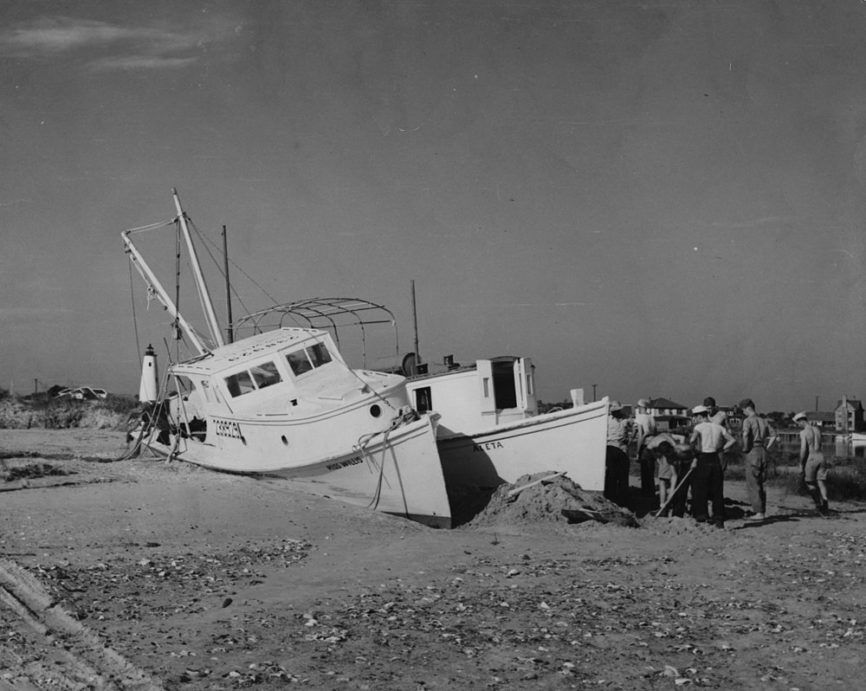There is in some places a perception that hurricanes are frequent visitors to the Outer Banks. They’re not. They are a part of life here, but their appearance is more the exception than the norm.
Most of them come and go, usually with some power disruptions, tree limbs down, and a lot of clean up. Not all of them, of course—Dorian being the most recent example of a storm that will be embedded in our memory for some time.
Yet Dorian, as destructive as it was, has not been the only storm to ravage the Outer Banks. It may not have even been the most destructive.
The Great Atlantic Storm of 1944 was one of the most powerful storms to ever strike the eastern United States.

The September 14 storm never quite made landfall on the Outer Banks, but came so close to Cape Hatteras that the western edge of the eyeball passed over Hatteras Island. There were reports of residents thinking the storm had passed and going outside, caught in the sudden 100 mph plus gusts from the northwest as the wall passed.
Wind speeds of 110mph were recorded at the Hatteras Weather Station and the mercury sank to 27.97”.
After passing the Outer Banks, the storm accelerated quickly NNE passing over Long Island as a category 3 storm then taking aim on New England.
The damage to the Outer Banks and adjacent waters was extraordinary.
“Island and the Banks Isolated from the World by Thursday Storm” the page one headline read for the Friday, September 15 Dare County Times. The page two headline told of the devastation on Ocracoke. “Red Cross Goes to Aid of Storm-Wrecked Ocracoke in Hyde” the headline read.
“Area representatives…went to Ocracoke Saturday and made a survey of the damage. They report much destruction and on their arrival found the island without drinking water and only enough food for one day,” the paper reported.
The situation on the Outer Banks was bad, but not nearly so dire.
The storm “…swept away the power lines and piles across Currituck Sound and Roanoke Sound,” the paper reported leaving the area without power or phones.
Equally as devastating—perhaps even more so—all the bridges connecting Manteo with the mainland and the Outer Banks were damaged and could not be used. Farther north at Coinjock, “Lower Currituck and Dare County were cut off from travel facilities, when a barge blown before the wind, crashed into the bridge at Coinjock, damaging the locks so badly that it will take two or three days before the bridge can be restored…”
Not reported in the paper, probably because communication was so difficult with phone lines down, was the disaster that had occurred in Avon.
Hoping to protect the village from the sea, the CCC (Civilian Conservation Corps) had built a sand dike along the beach. When the eye passed and the winds shifted to the northwest, a wall of water from Pamlico Sound rushed in. Before the dike had been built, the water would have washed out to sea, but now, with no place to go, the flood was devastating, damaging almost every home and business in Avon.
Remarkably only one person died in North Carolina and that tragically was in Nags Head. “No lives were lost…except L. S. Parkerson, the widely known and popular hotel manager at Nags Head who was electrocuted by a wire that had fallen on his car,” the Times reported.
The story at sea, though, was far direr.
The story of the US Coast Guard Cutters Jackson and Bedloe is one of the most tragic of the war.

The ships had gone to escort the liberty ship George Ade, which had been damaged by a torpedo attack. Under tow by a Navy ocean-going tug, the ships were making for Norfolk when the full fury of the storm struck.
Seas running as high as 50’-100’ were reported and the winds were sustained between 100-125 mph. The 125’ cutters, built in the 1920s to interdict rum runners during prohibition were no match for the Atlantic Ocean.
The Bedloe was overwhelmed first, sinking at 10:30 a.m. on September 14. Two and a half hours later, the Jackson followed her mate, slipping beneath the waves at 1:00 p.m.
Most of the men were able to get off the ships, but what followed were two excruciating days at sea as rescuers searched frantically for survivors. Of the 38 officers and men on the Bedloe, only 12 survived. There were 37 crewmen on the Jackson; 20 were rescued.
The George Ade made it to Norfolk with only minor damage.
